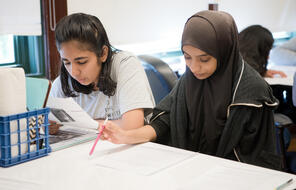
Finding Belonging in Our Passions and Interests
Duration
Two 50-min class periodsSubject
- English & Language Arts
Grade
11–12Language
English — USPublished
Get it in Google Drive!
Get everything you need including content from this page
Get it in Google Drive!
Get everything you need including content from this page
Overview
About This Lesson
While home is often categorized as something physical that can be recognized with borders and boundaries, existing concretely in time and space, there is another, more abstract concept of home that can exist in what we love to do. In reimagining “home” beyond its physical dimensions, we lift up Pico Iyer’s perspective that “home” transcends the geographic or physical realm and can instead reside in or emerge from our passions and pursuits. As Iyer explains in his TED Talk, “Home has really less to do with a piece of soil than, you could say, a piece of soul.” This sense of soul, for many, is found in creative expression, passions, and intellectual endeavors.
Through personal narratives that celebrate finding belonging in diverse passions, students will explore how engaging deeply in what we love creates a sense of home that is as boundless as it is profound. This lesson introduces students to the idea that home can be found in activities that ignite the soul—music, literature, science, or sports—offering a sanctuary for those who may not feel anchored to a specific location.
Lesson Materials
- Reading: “Be Like Wilt” by Neema Avashia
- Reading: From The Worlds I See by Dr. Fei-Fei Li
- Reading: “Coming into Language” by Jimmy Santiago Baca
- Handout: Personal Narrative Tasting Samples
- Handout: Personal Narrative Investigation
Essential Questions
-
How can reimagining “home” empower us to define how and where we belong in the world?
Guiding Question
-
How can our unique interests create homes and spaces where we find belonging?
Facing History Learning Outcomes
- Recognize the power that comes with telling their own story and engaging with the stories of others.
- Analyze the author’s representation of individual and collective agency in the text and compare and contrast it to their own beliefs and experiences in the world.
Lesson Plans
Day 1 Activities
Day 2 Activities
Unlimited Access to Learning. More Added Every Month.
Facing History & Ourselves is designed for educators who want to help students explore identity, think critically, grow emotionally, act ethically, and participate in civic life. It’s hard work, so we’ve developed some go-to professional learning opportunities to help you along the way.
Exploring ELA Text Selection with Julia Torres
On-Demand

Working for Justice, Equity and Civic Agency in Our Schools: A Conversation with Clint Smith
On-Demand

Centering Student Voices to Build Community and Agency
On-Demand













